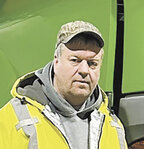

MARSHFIELD, Wis. — Saving time and labor as well as money spent on equipment are key reasons farmers choose to hire a custom operator for fieldwork. The speed at which crops can be harvested is another advantage of using a custom operator.
Rates for custom work vary, so farmers may wonder how custom operators determine what to charge. Knowing this information can eliminate shock when receiving a bill for custom work.
Equipment size and power can affect the rate charged. Larger pieces of machinery or equipment featuring advanced technology often garner a higher price tag. Many services are based on a per-acre cost, while other services, like chopping, are calculated by the hour.
Steve Salzmann operates Salzmann’s Custom Field Work near Marshfield, serving about 28 customers within a 50-mile radius, including 12 dairy farms. Salzmann is starting his fourth year of custom work, providing tillage, planting, chopping and combining services.
“Most of my customers hire me to do it all,” Salzmann said.
Salzmann charges $16 per acre for discing and soil finishing, $18 per acre for chisel plowing, $21 per acre for planting, and $30 per acre for combining soybeans and small grains like barley and wheat. For corn, Salzmann charges $35 per acre because he runs a shredder head, which shreds cornstalks while he combines.
“My rate for corn can vary,” Salzmann said. “If I don’t run the shredder head, I charge a little less.”
Salzmann’s rate for cutting hay is $17 per acre. For merging, he charges $16 per acre. Rates for hauling and chopping are configured by the hour. Chopping runs $385 per hour while hauling a tractor with 24-foot wagons is $100 per hour.
“I run a used chopper, so my rate is a little lower than some people’s,” Salzmann said.
Salzmann’s rates do not include fuel as the farmer is expected to supply that.
When determining rates, Salzmann consults with other custom operators in his area each year to get an idea of what they are charging.
“If they’re getting a new chopper, their rate goes up a little because of the price of the equipment and the technology that goes with it,” Salzmann said. “Since I have a used chopper, my monthly payments are less, so I can charge less than some of the other guys. I try to be more competitive and give the farmer a better price in the long run.”
Salzmann said some custom operators will calculate chopping and hauling rates according to tonnage. To do this, he said one must have a scale on their wagons and/or have a scale on hand for weighing.
“Newer choppers sometimes tell you the tonnage coming out,” Salzmann said. “Tonnage is hard to charge because you have to have a scale.”
Field conditions can affect pricing as well. Salzmann has raised rates a couple of times when he found rock in the ground during tillage and planting.
“Rocky ground beats the heck out of my equipment, and I could lose money on the job,” he said. “In those cases, I might charge more to cover myself if I have breakdowns.”
Salzmann occasionally offers discounts to farmers who use multiple services and pay their bill upon completion of the work, or soon thereafter.
“If it’s a hefty bill with multiple services, and I get paid within a week or two, I usually give a 5%-10% discount,” he said. “At one farm, I do all the tillage, planting, and combining and also go back in the fall to chisel plow so it’s ready for springtime. It’s a big expense, so I give him a discount because he pays me within two weeks.”
Before deciding which custom operator to go with, Salzmann recommends asking what kind of equipment the operator has.
“This gives the farmer a better understanding of why rates are what they are,” Salzmann said. “A question that is not fair to ask is, ‘How many tons per hour can you do?’ A lot of factors go into that, such as how far the haul is and the quantity of hay. If I’ve never chopped at that farm before, I would not know the answer.”
Custom operator Mike Maass, of Maass Farms, provides a variety of custom services, from planting and spraying to harvesting of forages and combining as well as installing field tile. Based in Seymour, Maass has been doing custom work for 14 years and serves about 18 customers in a 20-mile radius. Maass said the dairy farms he services milk anywhere from 50-350 cows.
“We charge mostly by the hour, and rates depend on machine size, etc.,” Maass said. “We have two self-propelled choppers.”
Last year, Maass charged $500 per hour to chop corn silage and haylage using his smaller, 600 horsepower chopper and $650 per hour when running his 800-plus horsepower chopper. His rate for planting is $22 per acre. Combining rates are $38 per acre for soybeans and $40 per acre for corn. Maass charges $8 per acre for spraying. Prices do not include fuel, as fuel is provided by the farmer.
Maass may raise prices this year to compensate for increased business costs.
“I’ve been eating some of the costs the last couple years with higher insurance rates and expensive parts,” Maass said. “Overall, everything is going up. The inflation rate went up so high that insurance is raising their rates 15%-20% this spring. The price of parts has also skyrocketed, putting us in a pinch.”
Things he used to be able to swap out, like a set of knives, have increased drastically, Maass said. Knives used to cost $3,500 but now cost $4,500-$5,000.
“Things are really getting out of control, and we haven’t changed our prices as needed,” Maass said. “We have to try to find a happy medium. As equipment gets bigger, faster and more efficient, we can put more things through, but that comes with a cost.”
Field size, driveways and access to the farm are other factors that can affect rates, Maass said.
“I have to charge some customers by the hour because getting on and off highways takes longer,” he said.
Brad Wichman, of Wichman Farms, uses a custom operator for harvesting hay and corn silage. Wichman and his family milk about 250 cows and farm 680 acres near Appleton.
“We use a custom harvester for time savings, efficiency and more consistent feed,” Wichman said.
For nine years, Wichman has called on Maass Farms to chop his corn silage. Last summer, he also began using their custom services for cutting, merging and chopping hay. The Wichmans do their own planting. The Wichmans have 140-150 acres of hay and 120-130 acres of corn harvested by Maass and his crew.
“The rest of the corn we combine, and we plant soybeans also,” Wichman said.
To help decide which custom operator to go with, Wichman said to first ask the following questions: What are they capable of doing? How much are they capable of handling? How much time do they have? What are they willing to do regarding harvest?
Every year, Wisconsin Custom Operators conducts a survey on rates charged by its members. The following data was gathered from the 2022 growing season.
The average combining rate was $38 per acre, planting was $24 per acre, and tillage was $17 per acre.
The average rate for crop preparation using a merger or mower conditioner was $16 per acre.
Average forage harvesting or chopping rates were as follows: corn silage with a 500-800 horsepower chopper was $570 per hour; corn silage with a chopper greater than 800 horsepower was $845 per hour; haylage with a 500-800 horsepower chopper was $487 per hour; and haylage harvested with a chopper greater than 800 horsepower was $720 per hour. All rates reflect the customer providing fuel.
Hauling rates were normalized to a 30-foot length to compare machine types. A semi came out at $96 per hour; a straight vehicle such as a chopper box on a truck was $118 per hour; and a tractor was $134 per hour.
Bagging rates averaged $8 per foot for a 10-foot diameter bag and $12 per foot for a
12-foot diameter bag. Pack tractor rates averaged $138 per hour when fuel was not included and $133 per hour when fuel was included.
Regardless of size or management philosophy, farmers can always use help in the fields. With a better understanding of how custom rates are determined and the average rates for services, farmers can make informed decisions in selecting a custom operator.
Comments
No comments on this item Please log in to comment by clicking here